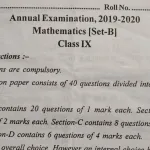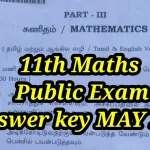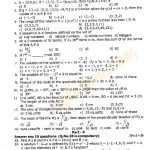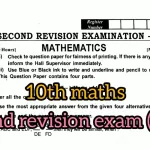The Class 8 DAV Board question paper is designed to comprehensively assess students’ understanding and knowledge across various subjects.
It typically includes sections on English, Mathematics, Science, and Social Studies, with each section tailored to test different skills such as comprehension, problem-solving, and critical thinking. The paper is structured to balance multiple-choice questions, short answer questions, and long-form responses, ensuring a holistic evaluation.
Dav class 8 board sample question paper with answers
Mathematics
1. Question: What is the formula for the area of a triangle?
Answer: The area of a triangle is \( \frac{1}{2} \times \text{base} \times \text{height} \).
2. Question: Simplify: \( 7x – 2(x – 3) \).
Answer: \( 7x – 2x + 6 = 5x + 6 \).
3. Question: Solve: \( 2x + 3 = 11 \).
Answer: \( x = 4 \).
4. Question: What is the Pythagorean Theorem?
Answer: In a right-angled triangle, \( a^2 + b^2 = c^2 \), where \( c \) is the hypotenuse.
5. Question: Find the volume of a cube with side length 4 cm.
Answer: Volume = \( 4^3 = 64 \) cubic cm.
6. Question: What is the quadratic formula?
Answer: \( x = \frac{-b \pm \sqrt{b^2 – 4ac}}{2a} \).
7. Question: Convert 0.75 to a fraction.
Answer: \( \frac{3}{4} \).
8. Question: If \( 3x = 12 \), find \( x \).
Answer: \( x = 4 \).
9. Question: Simplify: \( \frac{9}{15} \).
Answer: \( \frac{3}{5} \).
10. Question: What is the circumference of a circle with radius 7 cm?
Answer: Circumference = \( 2 \pi \times 7 = 14\pi \) cm.
Science
1. Question: What is the chemical formula for water?
Answer: \( H_2O \).
2. Question: Name the process by which plants make their food.
Answer: Photosynthesis.
3. Question: What is the unit of electric current?
Answer: Ampere.
4. Question: Define evaporation.
Answer: Evaporation is the process by which liquid turns into vapor.
5. Question: What is the main gas found in the Earth’s atmosphere?
Answer: Nitrogen.
6. Question: What is the boiling point of water at sea level?
Answer: 100°C (212°F).
7. Question: Name the three states of matter.
Answer: Solid, liquid, gas.
8. Question: What is the function of the heart?
Answer: To pump blood throughout the body.
9. Question: Which organelle is known as the powerhouse of the cell?
Answer: Mitochondria.
10. Question: What is the symbol for sodium?
Answer: Na.
English
1. Question: Define a simile.
Answer: A simile is a figure of speech that compares two things using “like” or “as”.
2. Question: What is the main theme of “The Road Not Taken” by Robert Frost?
Answer: The theme is about choices and their consequences.
3. Question: What is the difference between a metaphor and a simile?
Answer: A metaphor makes a direct comparison without using “like” or “as”, while a simile uses “like” or “as”.
4. Question: What is an adjective?
Answer: An adjective is a word that describes a noun.
5. Question: Who wrote “Pride and Prejudice”?
Answer: Jane Austen.
6. Question: What is the past tense of “go”?
Answer: Went.
7. Question: Define alliteration.
Answer: Alliteration is the repetition of the initial consonant sounds in a series of words.
8. Question: What is a synonym for “happy”?
Answer: Joyful.
9. Question: What is the subject in the sentence “The cat sat on the mat”?
Answer: The cat.
10. Question: What is a noun?
Answer: A noun is a person, place, thing, or idea.
Social Science
1. Question: What is the capital of France?
Answer: Paris.
2. Question: Who was the first President of the United States?
Answer: George Washington.
3. Question: What is the longest river in the world?
Answer: The Nile River.
4. Question: What is the primary function of the United Nations?
Answer: To promote peace and security internationally.
5. Question: Who wrote the Indian National Anthem?
Answer: Rabindranath Tagore.
6. Question: What are the three branches of the United States government?
Answer: Legislative, Executive, Judicial.
7. Question: Define democracy.
Answer: Democracy is a form of government where the power lies with the people, who can vote to elect their leaders.
8. Question: What is the significance of the year 1947 for India?
Answer: India gained independence from British rule.
9. Question: What is the main cause of the seasons on Earth?
Answer: The tilt of the Earth’s axis.
10. Question: Who was Mahatma Gandhi?
Answer: A leader of the Indian independence movement and advocate for nonviolent resistance.
Education in DAV Class 8: A Comprehensive Guide
DAV (Dayanand Anglo Vedic) Schools are among the most prestigious educational institutions in India, known for their emphasis on holistic education that balances academics with moral and ethical development. Class 8, in particular, is a pivotal year in a student’s academic journey, serving as a bridge between middle school and high school. This stage is crucial for laying a strong foundation in various subjects, which will support students in their higher education and future careers. This article delves into the curriculum, teaching methodologies, and overall development of students in DAV Class 8.
Curriculum Overview
The curriculum for DAV Class 8 is designed to provide a comprehensive education that encompasses a wide range of subjects, including Mathematics, Science, English, Social Science, Hindi, Sanskrit, and Computer Science. Each subject is structured to build on the knowledge acquired in previous years while introducing more complex concepts and skills.
Mathematics
Mathematics in Class 8 focuses on enhancing analytical and problem-solving skills. The syllabus includes:
- Algebra: Introduction to algebraic expressions, identities, and equations.
- Geometry: Concepts of lines, angles, triangles, quadrilaterals, and practical geometry.
- Mensuration: Understanding and calculating the area, volume, and surface area of various shapes.
- Data Handling: Basics of statistics, probability, and graphical representation of data.
- Rational Numbers: Operations and properties of rational numbers, including decimals and fractions.
Mathematics is taught through a combination of theoretical lessons and practical exercises, ensuring that students can apply mathematical concepts to real-life situations.
Science
Science education in Class 8 is divided into three main branches: Physics, Chemistry, and Biology. The curriculum aims to develop a scientific temper and a deeper understanding of natural phenomena.
- Physics: Topics include force and pressure, friction, sound, and the fundamentals of light and optics.
- Chemistry: Focuses on the study of materials, their properties, and changes. Topics like synthetic fibers, plastics, metals, and non-metals are covered.
- Biology: Encompasses the study of cells, microorganisms, reproduction in animals and plants, and human body systems.
Practical experiments and laboratory sessions are integral to science education, allowing students to observe and understand scientific principles firsthand.
English
The English curriculum aims to enhance language skills, including reading, writing, listening, and speaking. Key components include:
- Literature: Study of prose, poetry, and drama from diverse genres and periods.
- Grammar: In-depth understanding of grammatical rules and their application.
- Writing Skills: Development of various forms of writing, such as essays, letters, reports, and creative writing.
- Reading Comprehension: Techniques for understanding and analyzing texts.
English classes often involve interactive activities like debates, discussions, and presentations to foster confidence and communication skills.
Social Science
Social Science in Class 8 is divided into History, Geography, and Civics. The aim is to provide students with a comprehensive understanding of their social environment and its historical and geographical context.
- History: Covers Indian history, including ancient, medieval, and modern periods, with a focus on significant events and figures.
- Geography: Study of physical and human geography, including climate, natural resources, and population.
- Civics: Understanding of political science, including the functioning of government, democracy, and the constitution.
Field trips, projects, and interactive sessions are often used to make social science more engaging and relatable.
Hindi and Sanskrit
Language education in Hindi and Sanskrit is aimed at developing proficiency in these languages. The curriculum includes:
- Literature: Study of classical and contemporary texts.
- Grammar: Understanding and applying grammatical rules.
- Writing Skills: Composition, essays, and letter writing.
These subjects are essential for preserving cultural heritage and enhancing linguistic skills.
Computer Science
In today’s digital age, computer literacy is crucial. The Class 8 curriculum includes:
- Basics of Computers: Understanding hardware and software.
- Programming: Introduction to basic programming languages and coding.
- Internet and Networking: Basics of internet usage, safety, and networking concepts.
- Applications: Practical knowledge of software applications like word processors, spreadsheets, and presentation tools.
Latest Posts
- Step-by-step guide to download and apply for jee mains admit card 202
- Comprehensive 2025 government holidays and recruitment details for job seekers
- JEE Mains Admit Card 2025: Your Step-by-Step Guide to Downloading the Hall Ticket
- Everything You Need to Know About 2025 Government Holidays Recruitment
- Comprehensive Guide to rrb d group recruitment 2025 – Eligibility, Vacancies, and Application
- Detailed guide to nps trust recruitment 2025 vacancies, eligibility and apply process
- Comprehensive guide to hpcl recruitment 2025 notification, vacancies, and application process
- ignou bed admission 2025 complete recruitment guide with eligibility and process
- Comprehensive Guide to Indian Army Agniveer Recruitment 2025 Notification and Jobs
- Everything You Must Know About CBSE Board Exams 2025 Changes & New Rules






